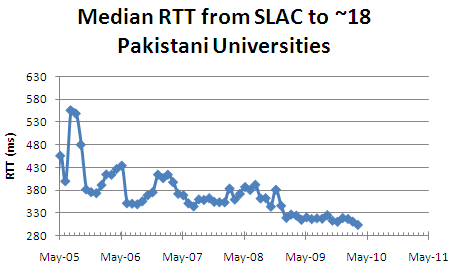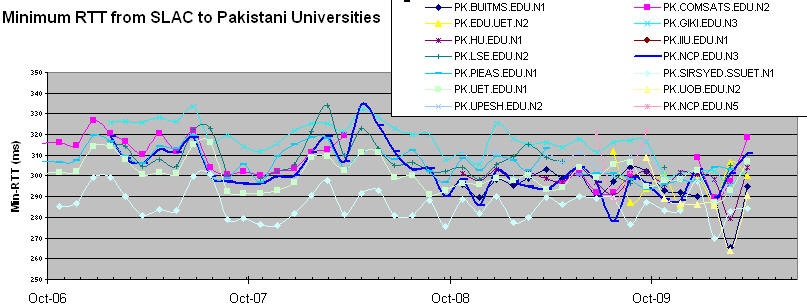Introduction
PERN (Pakistan) was the first South Asian country connected to TEIN3. It was connected in late 2008 thanks to a NSF/PERN funded 155 Mbps link to TEIN3 in Singapore. However looking at the traceroutes from Sri Lanka to Nepal, India and Pakistan, while the former two were connected by TEIN3, PERN (www.pern.edu.net) in Pakistan was connected through the commodity internet.
Explanation
From: Jawad Raza
Sent: 07 April 2010 10:29
The reason being that the IP addresses of our web servers are not being advertised on the TEIN3 network because of current bandwidth between TEIN3 and PERN2. The bandwidth of our TEIN3 link has being fully utilized by our research institutes, and we are at maximum utilization of the TEIN3 link. Due to the lack of bandwidth availability we have not made the PERN website available from TEIN3 network. That is the only reason for PERN website not being seen from the TEIN3 cloud.
On the other hand one can see from a plot of ping Round Trip Time (RTT) from SLAC to the National Centre for Physics in Islamabad (NCP (see below) that during the month of October 2008 the RTT dropped from over 360ms to under 310ms.
Looking at the other Pakistani universities the median RTT seen from SLAC to about 18 Pakistani universities dropped from about 370ms to under 320ms between oct 2008 and April 2009, see below:
More details can be found in the pk-rtt.xlsxspreadsheet of PingER measurements from SLAC to the Pakistani universities.
The Minimum RTTs from SLAC to Pakistani universities are shown below:
The Inter packet delay variation is shown below. It is seen that it has reduced (less jitter probably caused by reduced queuing and contention) considerably for NCP (a factor of 10 in October 2008. For other universities with a complete set of measurements it can also be seen to have reduced at different times, for example UET (the University of Engineering and Technology in Lahore) reduced form about 50ms to about 10 mis in October and November 2008 and PIEAS (Pakistan Institute of Engineering & Appliesd Sciences in Islamabad) reduced from about 60 ms to about 10 ms in May 2009. On the other hand the Ghulam Ishaq Khan Institute (GIKI) in Topi on the North West Frontier Province appears to not have improved until March 2010.
PingER can only measure the monthly loss rate down to 0.007% (since there are only 14400 pings = 10/30 min interval) thus the losses are no longer very instructive when the link performace improves beyond this level. In addition there is no obvious change in performance following Oct 2008.



